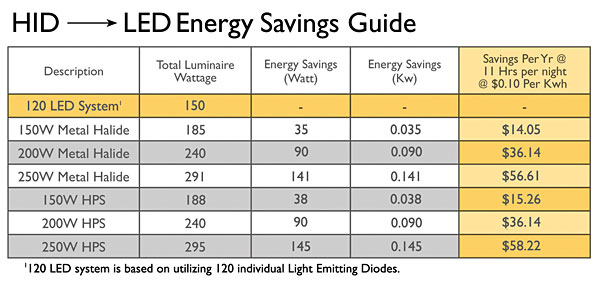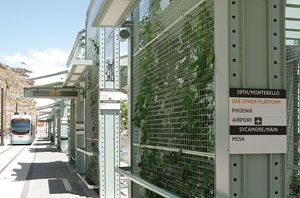Strategies for More Sustainable Exterior Solutions
STRATEGY #6: MEASURE 7:
Energy Flows & Energy Future
Sustainable design conserves energy and resources and reduces
the carbon footprint while improving building performance and
comfort. Sustainable design anticipates future energy sources
and needs.
LED Lighting − dark sky fixtures that save energy
In a recent Ken Burns documentary on the National Parks, a vivid image of the sky above Dinosaur National Park, located in Dinosaur, CO, revealed the majesty of the stars in the night sky. Most Americans now have to travel to see some of the major constellations because of light pollution. Manufacturers of light emitting diodes or LEDs believe that they have the optimal solution to meeting "sustainable sky" ordinances9 of many communities. LEDs are energy efficient and do not use any gas in their manufacturing process. The drivers used for operation contain no lead or mercury. Long life comparisons between LEDs and other types of lighting systems show that LEDs when properly installed can last up to 80,000 hours, many more than High Intensity Discharge (HID), fluorescent or incandescent light sources. Historically, LEDs have not been used for community street or site lighting; with recent advancements of LEDs, however, communities have a new option for saving money and reducing light pollution. And LEDs can now be used in street and site lighting to direct light where it is needed to avoid spilling onto adjacent properties, also known as light trespass.
 |
New LED lights save money and energy. Chart courtesy of Kim Lighting |
Â
In street and site lighting, there are two areas of light safety design to consider. Designers light the ground plane using low level luminaires such as bollards and pathway lights, or an entire area by properly placing controlled, low glare illumination that can be mounted as high as thirty-five feet from the ground plane.
Sustainable lighting requires that the luminaire, regardless of the light source, is controlled to light the area required for safety without sacrificing the view of the night sky above. New LED lights with modular components or linear strips are designed to harness and direct LED light output.
LEDs continue to improve and have not reached their full potential, but it is already evident that they will save energy on many levels. The potential uniformity with LED allows the customer to use lower wattage to create safer environments with less money. As an example: A 150-Watt LED fixture could replace a 250-Watt Metal Halide product that uses 291-Watts of energy and save $56.00 per year on energy alone ($0.10/Kwh @ 11-hr per night). The additional savings are for not having to replace lamps every three years. Earlier LED light output performance was suitable for low level and landscape lighting, but with proprietary, micro-emitter technology and advances in LED technology, the diodes can be placed in individual modules and angled into any position, focused to provide the required lighting on the surface area. The DOE and ENERGY STAR are currently reviewing new criteria for lighting interior and exterior surfaces, to provide guidance for architects seeking to choose the most energy efficient strategy for their purposes.
"By 2011, the ENERGY STAR program will expand to include a wide variety of LED applications for general lighting. Until then, the ENERGY STAR program will identify specific types of lighting applications where LED performance is suitable for inclusion in the program prior to 2011. Some of these near-term applications will include street and area lighting, parking garage lighting, cove lighting, ceiling fan light kits, replacement bulbs, and display, accent and wallwash lighting."10 ENERGY STAR provides guidance as to specifying color temperature, spatial uniformity, color maintenance, rendering and off-state power (which means that the light should not draw power when turned off).
 |
Chart showing options for color selections for LED lighting, including those for wildlife zones. Chart courtesy of Kim Lighting |
Â
| Arizona State University Study |
As part of a mechanical system, planted screens can shade a surface of a building providing as much as a forty percent swing in temperature, providing cooling relief in a tempered zone between the building and the exterior. In a study at Arizona State University's School of Architecture, planted green walls were designed to affect temperature along the light rail waiting platforms independent of a building structure. This study demonstrated that the ambient temperature was 8 to 10 degrees lower near the screens and also reduced radiant temperatures. Researchers used the standard effective temperature (SETA) index,11 to determine that the use of the green screen would support an ambient temperature that was acceptable for thermal comfort. The study measured high temperatures on the side of the screen with heat radiating sources and established lower values on the other, as well as a change in the humidity ratio. The cooling effect was a result of the evapotranspiration of leafy vines on the planted screen that provided both visual screening as well as temperature and humidity changes. In addition, studies from Germany show that biofilters remove particulates from the urban environment. Using plant materials in wall systems reduces noise as well as removes dust from the environment. |
 |
Planted screens cool passengers waiting for their trains in Phoenix, Arizona. Photo Courtesy of: greenscreen® |
Designers who are concerned that color is limited by choosing the formerly "blue" LED will now be able to choose from a range of color temperatures. According to April Ruedaflores, Marketing Manager at Kim Lighting, "the first LEDs used in site and area lighting were limited in color temperature ranges." Today's LEDs can be offered throughout the spectrum, ranging from 5100 Kelvin (bright white) to the very yellow/orange light similar to High Pressure Sodium color range of 1700 Kelvin (amber). In fact, wildlife organizations lobbied for these amber colored lights for wildlife protection in coastal areas. The brighter lights, although more attractive to humans, disrupted nesting patterns of many species.
LEDs produce a lot of heat as well as light and as a single source, they can fail before their projected lifetime if not well ventilated. Manufacturers are designing internal thermal management systems to control the heat by creating housings that have aluminum conduits that provide a channel for the heat to be exhausted by cooling ventilators on top of light fixtures. LEDs also have drivers, similar to the ballast requirement of fluorescent and HID light sources. Good driver design is important as the driver also impacts the heat accumulation in the housing. Drivers also control the voltage output. All drivers are UL tested and drivers are rated for efficiency. Thermal management by design increases the LEDs output and longevity as well as the energy efficiency of LED lighting systems.
LEDs maximize their efficiency in cold climates but the expected output will depreciate in hot and humid climates. Although still providing an output greater than the alternatives, LED manufacturers provide charts indicating performance based on average outdoor ambient temperatures.
CONCLUSION
According to the AIA Committee on the Environment, "Sustainability envisions the enduring prosperity of all living things. Sustainable design seeks to create communities, buildings, and products that contribute to this vision."12 Professionals are able to take advantage of new materials, new systems and new methods to assist them in achieving their vision of environmental sustainable design.
| ENDNOTES |
| 1Â http://www.aia.org/practicing/groups/kc/AIAS077365 2 Bryan, Harvey, Ph.D. "Outdoor Design Criteria: for the Central Phoenix/East Valley Light Rail Transit System. School of Architecture, Arizona State University. http://www.design.asu.edu/msenergy/Neeraj/Bryan.pdf 3 Deeks, D'Arcy, 2007 Ironsmith Environmental Impact Study. 4Â http://www.coloradotrees.org/benefits.htm 5Â http://www1.eere.energy.gov/buildings/commercial_initiative/index.html 6Â http://www.encyclopedia.com/doc/1G1-174258995.html 7 Data provided by Formulated Solutions based on research by: Baird, George BSc, MSc, Phd, CEng, Andrew Alcorn, BBSc, BArch, and Phil Haslam, BBSc, BArch. "The Energy embodied in building materials − updated New Zealand coefficients and their significance."; Kim, Jong-Jin, assistant Professor of Architecture, and Brenda Rigdon, project intern, College of Architecture and Urban Planning, The University of Michigan. "Sustainable Architecture Module: Qualities, Use and Examples of Sustainable Building Materials"; and Hammond, Professor Geoff and Craig Jones, Sustainable Energy Research Team (SERT), Department of Mechanical Engineering, University of Bath, UK. "Inventory of Carbon and Energy (ICE)". 8 Rohm and Haas, Technical Report. "Moisture Vapor Transmission Rate Testing." January 30, 2009 9 LaLiberte, Mark. "Understanding Vapor Barriers,"http://www.ecohomemagazine.com/building-science/understanding- vapor-barriers.aspx?page=2 10Â http://www.darksky.org 11Â http://www.energystar.gov/index.cfm?c=ssl_res.pt_ssl_program 12Â http://www.aia.org/practicing/groups/kc/AIAS077365 |








